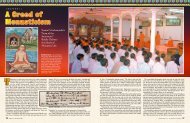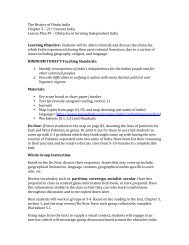A Simple, Traditional Worship Ceremony to Lord Ganesha that ...
A Simple, Traditional Worship Ceremony to Lord Ganesha that ...
A Simple, Traditional Worship Ceremony to Lord Ganesha that ...
You also want an ePaper? Increase the reach of your titles
YUMPU automatically turns print PDFs into web optimized ePapers that Google loves.
chapter 24A young Hindu family share in morning worship, asfather performs the traditional rite of worshipcalled puja, honoring and invoking the blessingsof the Elephant-Headed <strong>Lord</strong> of Dharma, theDeity worshiped by Hindus of all lineages.A <strong>Simple</strong>, <strong>Traditional</strong> <strong>Worship</strong> <strong>Ceremony</strong> <strong>to</strong> <strong>Lord</strong> <strong>Ganesha</strong> <strong>that</strong>Anyone Can Perform—with English Translation, IllustrationsAnd Internet Resources <strong>to</strong> Facilitate Learning the ChantsThe Hhindu form of home worship, known aspuja, is unique in all the world. Quite fittingly, itarises from the magnanimous spirit of hospitality<strong>that</strong> Hindu people are famous for. All guestsare received and treated as God in the Hindu home, andGod is no exception. During thisdaily morning rite, family membersgather in their well-appointedshrine room <strong>to</strong> honor God astheir royal guest. They receive Himwarmly, offer a seat, serve water <strong>to</strong>quench His thirst, bathe and dressHim in beautiful clothes, burn thefinest incense for His enjoyment,honor Him with light and flowersand feed Him a sumptuous meal.It is an intimate, personal interactionwith God. Throughout thepuja, the officiant chants sweetly<strong>to</strong> the Deity in Sanskrit, describingthese kindly acts and beseechingHis blessings. Finally, he thanks theDeity for His presence, bids Himfarewell and humbly apologizes forany errors he may have committed.It is a ritual performed daily inmillions of homes. In a sense, eachHindu has a private temple right inthe home, and invites God <strong>to</strong> abidethere, close <strong>to</strong> the family. Mystically,it keeps open the channels <strong>to</strong> the superconscious, divineareas of the inner worlds, bringing peace, health, prosperityand happiness <strong>to</strong> family members. Intellectually, itkeeps religious beliefs strong. Emotionally, it cultivates aburgeoning love of God, known as bhakti. Puja literallymeans “worship, adoration.” Home puja is a personal versionof the public puja performed in temples by priests.The forms of puja vary widely between Hinduism’s fourmain denominations and its hundreds of lineages, but allpuja finds its basis in sixteen offerings, shodasha upachara.These also vary somewhat, dependingon the scriptural source <strong>that</strong> isfollowed, but one popular list is thefollowing: 1) Åvâhanam, invoking;2) Åsanam, offering a seat; 3) Pâdyam,offering water for cleansingfeet; 4) Arghyam, offering waterfor cleansing the palms; 5) Åchamanîyam,sipping water; 6) Snânam,ceremonial bath; 7) Vastram,offering vestments; 8) Yaj ñopavîtam,offering sacred thread;9) Chandanam, offering sandalwoodpaste; 10) Pushpam, offeringflowers; 11) Dhûpam, burningincense; 12) Dîpam, waving lightedcamphor; 13) Naivedyam, offeringfood; 14) Añjali, praying withfolded hands; 15) Pradakshinâ, circumambulation; 16) Udvasanam,farewell. <strong>Lord</strong> <strong>Ganesha</strong> is the Godhonored and worshiped by all Hindus,so here we present a puja forthis universally beloved, boon-giving<strong>Lord</strong> of Beginnings and Rulerof Obstacles, which can be performed by anyone, youngand old, Hindu or non-Hindu, Vaishnava or Shakta, Saivaor Smarta. It is <strong>Lord</strong> <strong>Ganesha</strong> who bridges all distinctionsand unifies all peoples, and it is through His worship <strong>that</strong>we ultimately come <strong>to</strong> know all the other Gods.For puja supplies, Deities and202 what is hinduism? more, visit www.minimela.compho<strong>to</strong>s by dinodia
dinodiaFamily members havedonned traditional clothingand gathered in their shrineroom for morning worship.They are just completingtheir preparations and areabout <strong>to</strong> begin the dailyritual <strong>that</strong> keeps theirhome safe, harmoniousand spiritually vibrant.pho<strong>to</strong>s courtesy yale university press/stephen p. huylerUnlike the puja we are presentingin this chapter, some homepujas are long and elaborate.Here a priest performs a longSiva puja in an Indian homeshrine during Mahasivaratri.Puja, the worship of a murtithrough water, lights and flowersin temples and shrines, is theAgamic counterpart of the Vedicyajna rite, in which offerings areconveyed through the sacredhoma fire. These are the twogreat streams of adorationand communion in Hinduism,drawn from Hinduism’s twomassive compendiums ofrevealed scripture—theVedas and the Agamas.Instructions for Establishing a Home ShrineAnd Performing Puja <strong>to</strong> <strong>Lord</strong> <strong>Ganesha</strong>In performing the puja, preparation is of utmost importance—gathering flowers, cleaning the altar and puja tray, makingready the oil lamps and preparing the fruit and/or cookedfood offering. It is common <strong>to</strong> chant a <strong>Ganesha</strong> mantra or softlysing devotional songs while performing these tasks. This quietsthe mind and brings one’s awareness close <strong>to</strong> Him. Indeed, all thispreparation is an integral part of worship.As you see in the pho<strong>to</strong>s, there are a number of traditionalimplements needed for the puja, such as a metal tray, holy watercups and spoons, ghee lamp, camphor lamp, as well as pujasupplies, like holy ash and sandalwood paste. These are nowavailable at Indian grocery s<strong>to</strong>res, and online at www.minimela.com. For more information on setting up an altar, see Chapter22, “Hindu Home Sanctuary”Before beginning the puja, check the altar <strong>to</strong> make sure allnecessary articles are there, so <strong>that</strong> you don’t have <strong>to</strong> interruptthe flow of puja <strong>to</strong> get a missing item. Arrange all the items thesame way for each puja so you can reach au<strong>to</strong>matically whenneeded, with those most frequently used closest at hand.Hold the attitude <strong>that</strong>, as pujari, you are a servant of the Gods,a channel for the spiritual energies. Only thoughts of God are onyour mind as you perform puja, thus enhancing the outpouring ofdivine blessings. Tradition provides a caution: you should neverperform puja during or within 31 days of experiencing severeanger or other deep emotional upset, but it is all right <strong>to</strong> attend.Also, puja is not performed or attended by women during theirmenses, or by anyone who has a wound <strong>that</strong> is bleeding. Puja is ayoga, or link, between this and inner worlds. Therefore, you mustbe at your best in mood and emotion <strong>to</strong> assist in making this connection.Before performing puja, you should be freshly dressed,clean and undistracted by daily concerns. Having bathed beforehand,enter the shrine room and prostrate.The form of prostration differs for men and women. Men perform“eight-limbed obeisance,” ashtanga pranama, a fully pronepose in which hands, chest, forehead, knees and feet <strong>to</strong>uch theground. Women perform “five-limbed obeisance,” panchangapranama, a kneeling pose in which hands, head and knees <strong>to</strong>uchthe ground (with ankles crossed, right over the left).When everything is ready, take your seat in a cross-leggedposture in front of and <strong>to</strong> the left of the altar, facing the Deitybut turned slightly <strong>to</strong> the right. Close your eyes, sit quietly for amoment and tune your nerve system <strong>to</strong> God <strong>Ganesha</strong> and thesacred puja you are about <strong>to</strong> perform. If others are attending, becareful not <strong>to</strong> sit directly in front of the Deity, thereby blockingtheir view of the altar. Generally one remains seated throughoutthe ritual, though in some shrines it may be more comfortable<strong>to</strong> stand during the arati or throughout the puja. When smallchildren are in the home, the shrine room is locked so they donot disturb the contents. If a lockable room is not available, thealtar is raised so as <strong>to</strong> be out of reach, and the puja is performedstanding up. Those attending will usually sit during most of theceremony, then stand during the final arati. However, this againmay be left <strong>to</strong> individual discretion in consideration of the heigh<strong>to</strong>f the shrine.During the ritual, you will be making many offerings. Most offeringsare made with the right hand, never just the left, thoughthere are occasions when both hands are used.The offering of food is an important part of puja. <strong>Traditional</strong>lya simple dish of cooked rice is prepared especially for theDeity, with cooking utensils reserved for this purpose alone. Ifcooked food is not offered, then freshly cut fruit may be substituted.Keep the offering covered until the point in the puja whenthe pranas (life energies) of the food are offered <strong>to</strong> the Deity.Keeping the food covered helps <strong>to</strong> preserve purity and containthe pranas, which the Gods and devas can see, absorb, enjoyand reflect back <strong>to</strong> cleanse the auras of devotees. After the puja,the food offerings—along with holy ash (vibhuti), sacred water(tirtha), sandalwood paste (chandana), red powder (kumkuma)and flowers (pushpa)—are passed out and enjoyed as prasada.A recording of sacred chanting from the Vedas may be playedsoftly before the puja begins. At the high point, as the arati ispresented, loud drums and nagasvaras resound. As the sacramentsare passed out by the pujari, the divine musical ragas areheard softly played on the vina, or Vedic chanting or devotionalsongs may be played.After the sacraments are passed out, encourage everyone <strong>to</strong>sit quietly for a while <strong>to</strong> enjoy the sannidhya, the ever-presentfeeling of the Divine, <strong>that</strong> the God, Gods, inner-plane gurus anddevas suffuse in the shrine room. Such internalized worshipnaturally follows a puja. Those who perform daily japa will findthis an ideal time for <strong>that</strong> sadhana.Internalizing worship in this way gives you and all members ofthe family strength <strong>to</strong> face the outside world, its daily challengesand, yes, school tests. Internalizing worship is the core of theSanatana Dharma. It is the root, stem and blossom of the highestchakra, the 1,000-petalled lotus. It is the force <strong>that</strong> gives thestrength <strong>to</strong> resist temptation, <strong>to</strong> turn others from their bad waysand <strong>to</strong> face up <strong>to</strong> and live through birth karmas, prarabdha karmas,<strong>that</strong> are brought with you in this life. It gives the courage<strong>to</strong> resist making new, especially unwanted, karmas <strong>to</strong> be facedat a later date. It gives the willpower needed in this Kali Yuga <strong>to</strong>survive. It gives the love which provokes the understanding <strong>to</strong>overlook and forgive, then forget. Finally, internalized worshipgives the peace of mind, the shanti, in which all saints, sages,mahatmas and great seers dwell, in their jnana, their wisdom, ofhow things work in their universe of which we are a vital part.Many people are hesitant <strong>to</strong> do puja, specific, traditional ritesof worship, because they feel they don’t have enough training ordon’t understand the mystical principles behind it well enough.Most Hindus depend on the priests <strong>to</strong> perform the pujas and sacramentsfor them, or <strong>to</strong> train them <strong>to</strong> perform home puja and givethem permission <strong>to</strong> do so through initiation, called diksha. However,simple pujas, such as this one, may be performed by anyonewishing <strong>to</strong> invoke grace from God, Mahadevas and devas. Mothers,daughters, aunts, fathers, sons, uncles, all may perform puja withintheir own home, and do, as the Hindu home is considered <strong>to</strong> benothing less than an extension of the nearby temple.The <strong>Ganesha</strong> puja presented on the following pages consists ofa series of Sanskrit chants <strong>to</strong> be in<strong>to</strong>ned while performing theindicated actions and visualizations. Each chant is given in threeforms, first in Sanskrit’s traditional Devanagari script, secondin transliterated for those who speak English, and third in a204 what is hinduism? chapter 24: home puja 205
¥‹œ¥AºÎPushpamOfferingFlowersÆ‹¥⁄¿ ºóÓƒŸ’Ÿ≤Î –º¥@æŸ⁄º |¥›úŸ¨@Ä ≤Ÿ≤Ÿ⁄∆∞¥& ¥‹œ¥Ÿ⁄® –º¥@æŸ⁄º |tadupari maˆgalâkshatân samarpayâmipûjârtham nânâvidhapatra pushpâ∫i samarpayâmiWe now offer this auspicious un broken rice. And forthe fulfillment of our devotion, we offer many kindsof fresh, blooming flowers, our peerless <strong>Lord</strong>.A pinch of rice is offered with the first line. Ahandful of flowers is offered with the second.∞›¥ºÎDhûpamOfferingIncenseF ∆≤—¥´æ‹Øˆ∆ÊÅ ⁄Æ…æÊÅ ≤Ÿ≤Ÿí≥∞–º⁄≥∆ÊÅ |ÇŸî˘‰æ∞›¥Æ¤¥AŸ≤ŸÄ ∞›¥ËÉæ~ ¥˘⁄퇓¯ŸºÎ ||ÆÀŸóÓÄ í‹ì틃Ÿ‰¥‰~ –‹í≥∞~ –‹º≤Ë“¿ºÎ |ÇŸî˘‰æÅ–∆@Ɖ∆Ÿ≤ŸÄ ∞›¥Ÿ‰Éæ~ ¥˘⁄퇓¯ŸºÎ ||∞›¥ºŸî˘Ÿ¥æŸ⁄º ∞›¥Ÿ≤≥¿ºŸòº≤¤æ~ –º¥@æŸ⁄ººóÓƒŸ’Ÿ≤Î –º¥@æŸ⁄ºAum vanaspatyudbhavai˙ divyai˙nânâgandhasamanvitai˙,âghreyadhûpadîpânâm dhûpo-yam pratig®ihyatâm.daßâˆgam guggulopetam sugandhan sumanoharam,âghreya˙ sarvadevânâm dhûpo-yam pratig®ihyatâm.dhûpamâghrâpayâmidhûpânantaram âchamanîyam samarpayâmimaˆgalâkshatân samarpayâmiThe finest incense, of magical qualities, of full and variedfragrances, <strong>Lord</strong> Ga∫eßa, we set aflame and offer <strong>to</strong> you inthis, our home. Incense of the finest resins and perfumes,incomparable in sweetness and aroma, <strong>to</strong> be inhaled andenjoyed by you and all the Gods and devas, we offer <strong>to</strong> youin this, our home. Eagerly we offer <strong>to</strong> you, our resplendent<strong>Lord</strong>, fine resin incense, of heavenly odor, bewitching<strong>to</strong> the mind, rising out of a ghee-fed flame. We offer it<strong>to</strong> you in this, our home. This fine incense we have dulyall pho<strong>to</strong>s by dinodianeed <strong>to</strong> pho<strong>to</strong>shopflame in<strong>to</strong> smokeoffered for your pleasure. And we again offer you cool,sweet water for sipping and auspicious unbroken rice.During this chant, make three circles before the Deity withlighted incense held in your right hand while ringing the bellwith your left hand. Complete the third circle and trace anAum as you chant the fifth line, dhûpamâghrâpayâmi. At<strong>that</strong> point raise the incense higher and ring the bell louder.Put the incense down, and recite the next two lines. Withthe first, water is offered, with the second, a pinch of rice.Ƥ¥ºÎDîpam≤Ê∆‰Ø¯ºÎNaivedyamOfferingThe LightF –Ÿùæ∆⁄@&æË¥‰~ ¥˘ŸùæºóӃƟæé~ |Ƥ¥~ ¥Õæ Æ柿ŸÀ‰ Ƥ≤∏≥∞Ë ≤ºËÉ—‹ ‰ ||FÄ ÇŸ∆Ÿ⁄“ŸªæÅ –∆Ÿ@ªæË Æ‰∆ŸªæË ≤ºÅ |⁄Æ…æ ºóӃƤ¥~ –≥ÆÀ@æŸ⁄º |Ƥ¥Ÿ≤≥¿ºŸòº≤¤æÄ –º¥@æŸ⁄º |ºóÓƒŸ’Ÿ≤Î –º¥@æŸ⁄º |aum sâjyavarti trayopetam prâjyamaˆgala dâyakam,dîpam paßya dayârâße dînabandho namo-stu te.aum âvâhitabhya˙ sarvabhyo devatabhyo nama˙,divya maˆgala dîpaµ sandarßayâmi,dîpânantaramâchamanîyaµ samarpayâmi,maˆgalâkshatân samarpayâmiO the Compassionate, the friend of devotees! See thislamp offered which is lighted with ghee and three wicksand which is the provider of abundant auspiciousness.Salutations <strong>to</strong> you!OfferingFood–´æ~ ´∆@‰≤ (chant in morning)àÄ ´∆Ÿ –´æ~‰≤ (chant if evening) ¥⁄¿⁄ŒZŸŸ⁄º |F Ǻ‡º—‹ Ǻ‡Ë¥—¿®º⁄– —∆Ÿ“Ÿ |FÄ í®‰ÀŸæ —∆Ÿ“ŸiI | FÄ í®‰ÀŸæ —∆Ÿ“ŸiI |FÄ í®‰ÀŸæ —∆Ÿ“ŸiI |satyaµ tvartena (chant if in morning)®itaµ tvâ satyena (if evening) parishiñchâmiAum am®itamastu am®i<strong>to</strong>pastara∫amasi svâhâAum ga∫eßâya svâhÁ, Aum ga∫eßâya svâhÁ,Aum ga∫eßâya svâhÁWe add Truth <strong>to</strong> Truth. Aum. May this sweetand pungent food be transformed in<strong>to</strong> nectar.We humbly offer <strong>to</strong> you this food.While reciting the first part of the mantra, uncover thefood offering. Then, while chanting the last line andAum! Salutations <strong>to</strong> all the Gods invoked! This divine,auspicious light we offer <strong>to</strong> you. After <strong>that</strong>, we offer youpure water for sipping and auspicious unbroken rice.Offer the oil light <strong>to</strong> <strong>Lord</strong> Ga∫eßa and ring the bell asyou chant this hymn. As with the incense, circle threetimes then draw the Aum with the flame. Then raisethe flame and ring the bell louder, then s<strong>to</strong>p ringing.Offer water, then a flower or a pinch of rice.ringing the bell, circle a spoonful of water over the foodand offer it <strong>to</strong> the Deity. While ringing the bell softly,gently waft the aroma and vital essences of the food orfruit <strong>to</strong>ward the Deity. Do this by sweeping the righthand over the food with a flower held between yourfingers, stem upward. The palm is facing downward asit moves over the food, then rotates upward as the sweepapproaches the Deity, bringing the aroma and prâ∫a<strong>to</strong>ward His nose and mouth. As you complete the thirdline, gently <strong>to</strong>ss the flower <strong>to</strong>ward the feet of the Deityat the end of the sweep with all the love in your heart.210 what is hinduism? chapter 24: home puja 211
F ÇŸ∆Ÿ⁄“ŸªæÅ –∆Ÿ@ªæË Æ‰∆ŸªæË ≤ºÅ |≤Ÿ≤Ÿ⁄∆∞º“Ÿ≤Ê∆‰Y~ ⁄≤∆‰ÆæŸ⁄º |樟À⁄#–º⁄¥@º“Ÿ≤Ê∆‰YºÎ é‚¥æŸ —∆¤é‹¡ |Aum âvâhitâbhya˙ sarvâbhyo devatâbhyo nama˙,nânâ vidha mahânaivedyaµ nivedayâmi,yathâßakti samarpita mahânaivedyam k®ipayâ svîkuruAum! Salutations <strong>to</strong> all the Gods invoked! Becausewe are offering you our very best, <strong>Lord</strong> Ga∫eßa, in allsincerity and love, please consider the essence of thisfood as among the finest meals you have ever received.To the best of our ability in the worship of you, we offerthis food and humbly beg <strong>that</strong> you will receive it.⁄∆îىø¿Ÿœ¢Ë%¿À≤ŸºŸ∆⁄ƒÅVighneßvarâsh†ottaraÍatanâmâvali˙Chanting Ga∫eßa’s⁄∆≤ŸæéŸæ⁄∆îÙ¿ŸúŸæíÈ¿¤¥‹&Ÿæí®‰Ã¸¿Ÿæ—é≥ÆŸí˘úŸæÇ…ææŸæ¥›ŸæÆ’ŸæDZ撟æ⁄ظú⁄¥˘æŸæVinâyakâya ......the remover (of obstacles)Vighnarâjâya .......the ruler of obstaclesGaurîputrâya .......... the son of GaurîGa∫eßvarâya ........the lord of categoriesSkandâgrajâya .....Skanda’s elder brotherAvyayâya ........... the inexhaustible onePûtâya .....................the pure oneDakshâya ............. the dexterous oneAdhyakshâya ..........the great presiderDvijapriyâya .... who loves the twice-bornÇ⁄ì≤í∆@⁄ôöƉ Agnigarvacçhide . .who destroyed fire’s egoÑ≥Æ˙Ã˘¤¥˘ÆŸæ Indraßrîpradâya who res<strong>to</strong>red Indra’s wealth∆Ÿ®¤¥˘ÆŸæ Vâ∫îpradâya ........ who gives eloquenceÇ…ææŸæ Avyayâya ........... the inexhaustible one–∆@⁄–⁄ØÛ¥˘ÆŸæ Sarvasiddhipradâya...giver of fulfillment–∆@≤æŸæ Sarvatanayâya ...........the son of ÍivaÍarvarîpriyâya ......... loved by PârvatîÀ∆@¿¤⁄¥˘æŸæ108 NamesRinging the bell loudly as you recitethe above chant, pick up a flower ora pinch of rice and hold it at chestheight in the fingertips of the righthand. As the last word is spoken,gently release the rice or flowerat the feet of the Deity. Then putdown the bell and raise your handsabove your head in devout prayer<strong>that</strong> Ga∫eßa will accept the meal.While your hands are raised, closeyour eyes and visualize Ga∫eßa acceptingand partaking of the meal.After a moment, lower yourhands and in<strong>to</strong>ne Aum quietly.In this section of the pûjâ, chant the “garland ofGa∫eßa’s 108 names.” As you in<strong>to</strong>ne each name, offerwith your right hand a flower, some flower petalsor a pinch of rice. The names are attributes of theDeity, each delineating an aspect of His wondrousnature. Each name is preceded by the mantra Aumand followed by nama˙, meaning “obeisance, adorationor homage <strong>to</strong>.” Thus the first line is chanted AumVinâyakâya Nama˙ (pronounced, “na-ma-ha”).–∆Ÿ@´ºéŸæ–‡⁄{é&‰AA@Ɖ∆ŸæSarvâtmakâya .............the soul of allS®ish†ikartre . . . . . . . . . . . . . . . . the crea<strong>to</strong>rDevâya ...............the resplendent oneÇ≤‰éŸ⁄ò@Ÿæ Anekârchitâya ...worshiped by multitudes⁄À∆Ÿæ Íivâya .................the auspicious oneÀ‹ØÛŸæ Íuddhâya ..................the pure one∏‹⁄ØÛ⁄¥˘æŸæ Buddhipriyâya .....who loves intelligenceÀŸ≥Ÿæ Íântâya .................the peaceful one∏˘“˜òŸ⁄¿®‰ Brahmachâri∫e .........the celibate oneíúŸ≤≤Ÿæ Gajânanâya ..........the elephant’s facedظʺŸ‹¿Ÿæ Dvaimâturâya ..... who has two mothersº‹⁄≤—‹Ÿæ Munistutâya ...... who is praised by sages∫è⁄∆îÙ⁄∆ Bhaktavighna vinâßanâya. . . . . . . . . . . . . who destroys devotees’ obstacles≤ŸÀ≤ŸæäéÆ≥Ÿæò‹∏@Ÿ“∆‰ò‹¿Ÿæall pho<strong>to</strong>s by dinodiaEkadantâya ............who has one tuskChaturbâhave ........who has four armsChaturâya ............ the ingenious oneÀ⁄è–~æ‹Ÿæ Íaktisaµyutâya ...... united with powerLambodarâya .......who has a large bellyƒ~∏ËÆ¿ŸæÀ›¥@鮟@æ“¿æ‰Íûrpakar∫âya . ........ with fan-like earsHaraye ...destroys evil with lion-like courage∏˘“˜⁄∆Æ‹%ºŸæ Brahmaviduttamâya foremost knower of GodKâlâya ..............the master of destiny韃Ÿæí˘“¥æ‰éŸ⁄º≤‰–˺–›æŸ@⁄íÙƒËò≤Ÿæ¥ŸÀŸñÍé‹ÀÙ∞¿Ÿæò©•Ÿæí‹®Ÿ¤Ÿæ⁄≤¿†Ú≤ŸæÇé≈ºŒŸæ—∆æ~⁄–ØÛŸæ⁄–ØÛŸ⁄ò@¥ÆŸΩ∏‹úŸæ∏¤ú¥›¿∂ƒŸ–èŸæ∆¿ÆŸæÀŸÃ¸Ÿæé‚⁄≤‰⁄ظú⁄¥˘æŸæ∆¤∫æŸæí⁄Æ≤‰ò⁄$®‰Ñ’‹òŸ¥∞‡‰Ã˘¤ÆŸæÇúŸæÜ´¥ƒé¿ŸæÃ˘¤¥æ‰—‹⁄“⁄Œ@ŸæGrahapataye .............lord of planetsKâmine .................... who is loveSomasûryâgni lochanâya. . . . . . . . whose eyes are the moon, sun and firePâßâˆkußa dharâya. . . . . . . . . . . . . . . who holds a noose and a goadCha∫∂âya ...........who is fierce-lookingGu∫âtîtâya ...... who transcends qualitiesNirañjanâya ..... who is without blemishAkalmashâya ... who is without impuritySvayaµsiddhâya .....self-fulfilled, perfectSiddhârchita padâmbujâya. . . . . . . . . . . . . . . whose lotus feet sages worshipBîjapûraphalâsaktâya. . . . . . . . . . . . . . . . who is fond of pomegranatesVaradâya .................the boon giverÍâßvatâya .....the eternal, unchanging oneK®itine ...................the skillful oneDvijapriyâya ...... fond of the twice-bornVîtabhayâya .............who is fearlessGadine ..............who wields the maceChakri∫e .............who wields a discusIkshuchâpadh®ite. . . . . . . . . . . . . . . . . who holds a sugarcane bowÍrîdâya .............the bes<strong>to</strong>wer of wealthAjâya ....................the unborn oneUtpalakarâya. . . . . . . . . . who holds a proud blue lotus flowerÍrîpataye ..............the <strong>Lord</strong> of wealthStutiharshitâya .... who delights in praise鋃Ÿ⁄Æ˙∫‡‰ú⁄¢ƒŸæé⁄ƒé≈ºŒ≤ŸÀ≤ŸæKulâdribh®ite.who supports Himâlaya, His family’s mountainJa†ilâya ............. who has matted hairKalikalmasha nâßanâya. . . . . . . . . . the destroyer of sins in the Kaliyugaò≥Æ˙ò›•Ÿº®æ‰ Chandrachû∂âma∫aye. . . . . . . . . . . . who wears a moon upon his headéŸ≥Ÿæ¥Ÿ¥“Ÿ⁄¿®‰–ºŸ⁄“ŸæÇŸ⁄Ã˘ŸæÃ˘¤é¿Ÿæ–ÈΩæŸæ∫è∆Ÿ⁄°öÆŸæéŸæÀŸ≥ŸæéÁ∆≈æ–‹êÆŸæ–⁄ôòÆŸ≤≥Æ⁄∆í˘“Ÿæ◊Ÿ⁄≤≤‰ÆæŸæ‹ŸæÆŸ≥Ÿæ∏˘“˜Ø¸‰Œ⁄∆∆⁄ú@Ÿæ¥˘º%ÆÊ´æ∫æAÆŸæÃ˘¤é©§Ÿæ⁄∆∏‹∞‰Ã¸¿Ÿæ¿ŸºŸ⁄ò@Ÿæ⁄∆∞æ‰≤Ÿí¿Ÿúæ◊Ë¥∆¤∆‰—¨›ƒé©§Ÿæ—∆æÄ é&‰AA@Kântâya ...........the beloved, loving onePâpahâri∫e .........the consumer of sinsSamâhitâya ...... absorbed in meditationÅßritâya ............... who is our refugeÍrîkarâya ....... who manifests prosperitySaumyâya ...............the amiable oneBhaktavâñçhita dâyakâya. . . . . . . . . . . . . . the gran<strong>to</strong>r of devotees’ desiresÍântâya .................the peaceful oneKaivalya sukhadâya. . . . . . . . . . . . . .bes<strong>to</strong>wer of unsullied liberationSacchidânanda vigrahâya. . . . . embodiment of existence-knowledge-blissJñânine ................the great wisdomDayâyutâya ........... full of compassionDântâya . ............ who has self-controlBrahmadvesha vivarjitâya. . . . . . . .who is free from aversion <strong>to</strong> knowledgePramattadaitya bhayadâya. . . . . . . . . . . . . . . . who brings terror <strong>to</strong> demonsÍrîka∫†hâya ........ with beautiful throatVibudheßvarâya ....... <strong>Lord</strong> of the WiseRâmârchitâya ....... worshiped by RâmaVidhaye .......... who is the destiny of allNâgarâja yajñopavîtavate. . . . . . . . . . .whose sacred thread is a king cobraSthûlaka∫†hâya ........... of s<strong>to</strong>ut neckSvayaµkartre ........ who is self-created–ŸºîËŒ⁄¥˘æŸæ Sâmaghoshapriyâya. . . . . . . . . . . who loves the sound of Sâma Veda212 what is hinduism? chapter 24: home puja 213
¥¿—ºÊ—¨›ƒ‹©•ŸæÇí˘©æ‰∞¤¿Ÿæ∆Ÿí¤ÀŸæParasmai ................ who is supremeSthûlatu∫∂âya..... who has a s<strong>to</strong>ut trunkAgra∫ye ..................... the leaderDhîrâya .............. the courageous oneVâgîßâya ..............the <strong>Lord</strong> of speech⁄–⁄ØÛÆŸæéŸæ Siddhidâyakâya ... bes<strong>to</strong>wer of fulfillmentDûrvâbilva priyâyaÆ›∆Ÿ@⁄∏≈∆⁄¥˘æŸæÇ…æ躛@æ‰. . . . . . . . who loves dûrvâ grass and bilva leavesAvyaktamûrtaye. . . . . . . . . .the manifestation of the UnmanifestÇÆÍ∫‹º›⁄@º‰ Adbhutamûrtimate ... of wondrous formÀʃ‰≥Æ˙≤‹úË´–óÓ ê‰ƒ≤Ë´–‹éºŸ≤–ŸæÍailendratanujotsaˆga khelanotsukamânasâyawho is happy <strong>to</strong> play in the lap of His mother,Pârvatî, daughter of the mountain <strong>Lord</strong>—∆ƒŸ∆©æ–‹∞Ÿ–Ÿ¿⁄ú º≥º¨⁄∆í˘“ŸæSvalâva∫yasudhâsârajita manmathavigrahâya… who defeated Manmatha, the God of love, by His sweet beauty–º— Samasta jagadâdhârâyaúíÆŸ∞Ÿ¿Ÿæ . . . . . . . . . . . . . . . the supporter of all the worldsºŸ⁄æ≤‰ Mâyine .........the source of illusory powerº⁄›Œé∆Ÿ“≤Ÿæ Mûshikavâhanâya . . who rides the mouseH®ish†âya . . . . . . . . . . . . . . . . .the joyful one„{Ÿæ‹{Ÿæ¥˘–≤ÙŸ´º≤‰–∆@⁄–⁄BÛ¥˘ÆŸæéŸæTush†âya .............. the contented onePrasannâtmane the bright kindly-souled oneSarvasiddhi pradâyakâya. . . . . . . . . . . . . . . . the gran<strong>to</strong>r of all fulfillmentÇŸ¿¤Åratî<strong>Worship</strong>With FlameF –ŸùÒ~ ⁄&∆⁄%@–~æ‹#~ ∆⁄“n≤Ÿ æË⁄ú~ ºæŸ |퇓Ÿ® ºóÓƒŸ¿⁄Ä ÖÀ¥‹& ≤ºËÉ—‹ ‰ ||FÄ ÇŸ∆Ÿ⁄“ŸªæÅ –∆Ÿ@ªæË Æ‰∆ŸªæË ≤ºÅ |⁄Æ…æºóӃƤ¥~ –≥ÆÀ@æŸ⁄º |ÇŸòº≤¤æÄ –º¥@æŸ⁄º |ºóÓƒŸ’Ÿ≤Î –º¥@æŸ⁄º |aum sâjyaµ trivartisaµyuktam vahninâ yojitaµ mayâ,g®ihâ∫a maˆgalâratim îßa putra namo-stu te.aum âvâhitâbhya˙ sarvâbhyo devatâbhyo nama˙divya maˆgaladîpaµ sandarßayâmiâchamanîyaµ samarpayâmimaˆgalâkshatân samarpayâmiº≥& ¥‹œ¥ºÎMantra Pushpam<strong>Worship</strong>With FlowersF æiËÉ¥ŸÄ ¥‹œ¥UÄ ∆‰ÆI |¥‹œ¥i∆Ÿ≤Î ¥˘UúŸ∆ŸIi≤Î ¥Àu‹ºŸ≤Î ∫I∆⁄ |òU≥Æ˙ºŸU∆Ÿ ÇU¥ŸÄ ¥‹œ¥ºIiÎ |¥‹œ¥i∆Ÿ≤Î ¥˘UúŸ∆IiŸ≤Î ¥À‹uºŸ≤Î ∫I∆⁄ |æ äu∆Ä ∆‰ÆI | æËAAIÉ¥ŸºUŸæi≤UÄ ∆‰ÆI |ÇUŸæI≤∆Ÿ≤Î ∫∆⁄ ||F Ã˘¤ º“Ÿí®‰Ã¸¿Ÿæ ≤ºÅº≥&¥‹œ¥Ÿ°ú⁄ƒ~ –º¥@æŸ⁄º |Aum yò-pâm pushpäµ vedà,pushpàvân präjâvâºn paßümân bhàvati,chändramÄvâ äpâm pushpamº,pushpàvân präjâvâºn paßümân bhàvati,ya ëvaµ vedà, yò-pâmÄyatànäµ vedà,Äyatànavân bhavati.Aum Írî Mahâga∫eßvarâya nama˙mantra pushpâñjaliµ samarpayâmiThe one who understandsthe beauty of the bloomingpowers of the Supreme Beingis blessed with beautiful,blooming life, progenyand cattle. The moon iscertainly the bloom of thosepowers. One who realizesthe qualities of the moon,which are nothing but theblooming divine powers,is blessed with a blooming,beautiful life of perfection, progeny and cattle. One who realizesthis principle and realizes the source from whom all these powers havecome himself becomes the abode of those divine powers. Aum, salutations,<strong>Lord</strong> Mahâga∫eßa, we respectfully offer you this flower mantra.all pho<strong>to</strong>s by dinodiaWhile chanting this mantra, hold a handful of flowers before youin añjali mudrâ, hands cupped loosely around the flowers at chestheight. Recite the verses with adoration. As you in<strong>to</strong>ne the last word,samarpayâmi, lower your hands (as shown in the pho<strong>to</strong>) and <strong>to</strong>ssthe flowers in<strong>to</strong> the air above the murti, sending a shower of blossomsupon the God with feelings of gratitude and loving devotion.O Ga∫apati, Son of God Íiva, please accept thisauspicious âratî prepared by me with ghee, three wicksand fire. My salutations <strong>to</strong> you! Aum! Salutations<strong>to</strong> all the Gods invoked! This divine, auspiciouslight we offer <strong>to</strong> you. After <strong>that</strong>, we offer you purewater for sipping and auspicious unbroken rice.During this chant, hold the lit oil lamp or camphor burnerin your right hand and the bell in your left. While ringingthe bell and slowly reciting the âratî mantra, make threecircles clockwise before Ga∫eßa with the flame. S<strong>to</strong>p at the<strong>to</strong>p of the third circle, lower the lamp slightly and tracethe symbol of Aum in Sansk®it or in your native language.¿’∞Ÿ¿®ºÍRakshadhâra∫amÑ≥Æ˙ —˺I‰≤¥ZŸÆUÀ‰≤Uº±æ⁄ºÆ~ ∆Ÿ‰I≤U –í¿I‰®¿’ ¿’Ÿ~ ∞Ÿ¿æŸU⁄º |indra-s<strong>to</strong>mèna pañchadäßenämadhyamïdaµ vâtènä sagarè∫araksha rakshâµ dhârayÄmiPrayer forProtectionThen lift the flame slightly above the Aum <strong>that</strong> you placedin the âkâßic ether and ring the bell louder for all threeworlds <strong>to</strong> hear. Keep ringing loudly while chanting theabove two-line salutation <strong>to</strong> the devas (“âvâ hitâbhya˙… sandarßayâmi”). Put down the bell and the lampand then, with the flame still burning, offer a spoonfulof water with “âchamanîyaµ samarpayâmi,” then apinch of rice with “maˆgalâshatân samarpayâmi.”O Indra, <strong>Lord</strong> of material and spiritual prosperity, pleaseprotect the space between the heavens and earth as well as themind between the body and the soul with the help of fifteennoble powers and virtues (five prâ∫as, five jñânendriyas andfive karmendriyas). Your protection and blessings sustain me.As you recite this mantra, make three circles above the burningflame with a flower held in the right hand, stem upward (pho<strong>to</strong>next page).With the last words, <strong>to</strong>ss the flower gently <strong>to</strong>ward theDeity and place your hands in añjali mudrâ while facing the altar.Now offer the flame at chest level <strong>to</strong> all present, allowing each <strong>to</strong>draw both hands through it and lightly <strong>to</strong>uch the eyes three times(pho<strong>to</strong> next page, upper right). The Gods and devas can see us214 what is hinduism? chapter 24: home puja 215
dinodiaÇ¥@®ºÍArpa∫amFinalConsecrationÇ≤æŸ æ¨Ÿ À⁄# é‚(state period of day)¥›úæŸ ∫í∆Ÿ≤Î –∆@ Ɖ∆Ÿ´ºéÅÃ˘¤ º“Ÿí®‰Ã¸¿Ÿ: –‹¥˘¤Å–‹¥˘–≤ÙË ∆¿ÆË ∫∆‹anayâ yathâ ßakti k®ita(state period of day from list on page I-4)pûjayâ bhagavân sarva devâtmaka˙ßrî mahâga∫eßvara˙ suprîta˙suprasanno varado bhavatuTo the best of our ability we have performedthis (state time of day) pûjâ and worshipedyou, dear <strong>Lord</strong>, the brightest of all the Gods.May it please you. May it be enjoyed by you.Surrounded by your presence, we placeourselves in your care, loving Ga∫eßa.through the flame andsend blessings. If especiallyhonored persons arepresent, such as one’s guru,parents or teacher, takethe flame first <strong>to</strong> them.Then proceed clockwise<strong>to</strong> the others. In somecases, the pujârî maystand near the altar whiledevotees come forward<strong>to</strong> receive the flame. Ifno one is attending thepûjâ, you may per sonallydraw blessings from theflame, but not otherwise.Finally, present theflame once more <strong>to</strong> theDeity, then extinguish itwith a wave of the righthand or by snuffing i<strong>to</strong>ut with a flower.dinodiaBefore reciting the above verse, place a pinch of rice in your left palm,then transfer it <strong>to</strong> the right palm. Add <strong>to</strong> the rice three spoonfuls ofwater and close the hand (left pho<strong>to</strong>). Hold the rice before you as youface the Deity, the left hand under the right hand, and recite the mantra.As you in<strong>to</strong>ne the last words, let the rice and water fall in<strong>to</strong> thetîrtha cup (right pho<strong>to</strong>). The sacraments may then be given out in thefollowing order: holy ash, blessed water, sandalpaste, red powder, foodand flowers. If no one is attending the pûjâ, you may partake of thesacraments yourself, but not otherwise. If many devotees are attending,a second person may help pass out the sacraments, except for theholy ash, which is always given by the person who performed the pûjâ.dinodiathomas kelly⁄∆–ú@≤ºÍVisarjanamSharing the blessedofferings: at left holyash is distributed, asmall pinch in<strong>to</strong> theright hand of eachdevotee; at right,the father of thishousehold appliesthe sacred dot on hisdaughter’s forehead.Below, the familyoffers final prayersat the conclusion oftheir morning puja.Farewell andApologiesF ÇŸ∆Ÿ“≤Ä ≤ úŸ≤Ÿ⁄º ≤ úŸ≤Ÿ⁄º ⁄∆–ú@≤ºÎ |¥›úŸ°òÊ∆ ≤ úŸ≤Ÿ⁄º ’ΩæŸÄ ¥¿º‰Ã¸¿ ||º≥&“¤≤~ ⁄$染¤≤ºÍ ∫⁄#“¤≤~ –‹¿‰Ã¸¿ |æÎ ¥›⁄úÄ ºæŸ Ɖ∆ ¥⁄¿¥›®@Ä Æ—‹ ‰ |Ç≥樟 À¿®ºÎ ≤Ÿ⁄— ´∆º‰∆ À¿®ºÎ ºº |—ºŸÎ 韡©æ∫Ÿ∆‰≤ ¿’ ¿’ í®‰Ã¸¿ ||F Î –Î FAum âvâhanaµ na jânâmi na jânâmi visarjanam,pûjâñchaiva na jânâmi kshamyatâm parameßvara.mantrahînaµ kriyâhînam bhaktihînaµ sureßvara,yat pûjitam mayâ deva paripûr∫am tadastu te,anyathâ ßara∫aµ nâsti tvameva ßara∫am mama,tasmât kâru∫yabhâvena raksha raksha ga∫eßvara.Aum tat sat Aum.O <strong>Lord</strong>, we do not know the proper means of invitingyou or, when taking our leave, how <strong>to</strong> wish you farewell.A full knowledge of priestly rites has not been imparted<strong>to</strong> us, so you must overlook and forgive any mistakes oromissions. We know little of mantras or pious conduct,and we are strangers <strong>to</strong> true bhakti. Nonetheless, pleaseforgive us and regard our attempts as exact and complete—becauseyou are our only refuge. With your compassionatenature, <strong>Lord</strong> Ga∫eßa, we beseech you, pleaseprotect those who pray. That which is Truth is Aum.dinodiadinodiaThis concluding apology is recited with hands inañjali mudrâ. It is a formal and devout end <strong>to</strong> theworship service. As the final words, “Aum tat satAum,” are spoken, it is cus<strong>to</strong>mary <strong>to</strong> clap your hands<strong>to</strong>gether three times. All may now prostrate.It is traditional and most uplifting <strong>to</strong> meditate for a fewminutes after the pûjâ, rather than rushing offer <strong>to</strong> dailyduties. There is great personal benefit in such internalizedworship, eyes closed, mind still, following, deep withinyourself, the prâ∫as <strong>that</strong> the pûjâ has created. Externalizedworship is the bhakti path; internalized worship isthe yoga path. Both <strong>to</strong>gether make the complete circle<strong>that</strong> sustains devotees in their spiritual life, making themstrong and kindly in moving the forces of the world in theirdaily life. This dual-pronged effort <strong>to</strong>wards self-transformationand right living is the very foundation for thefinal goal of all seekers: moksha, freedom from rebirth.216 what is hinduism? chapter 24: home puja 217
















